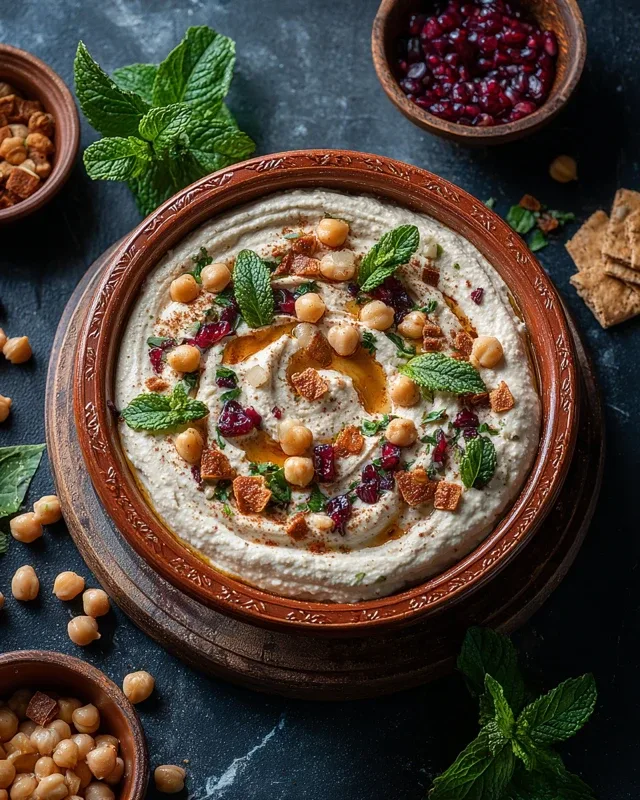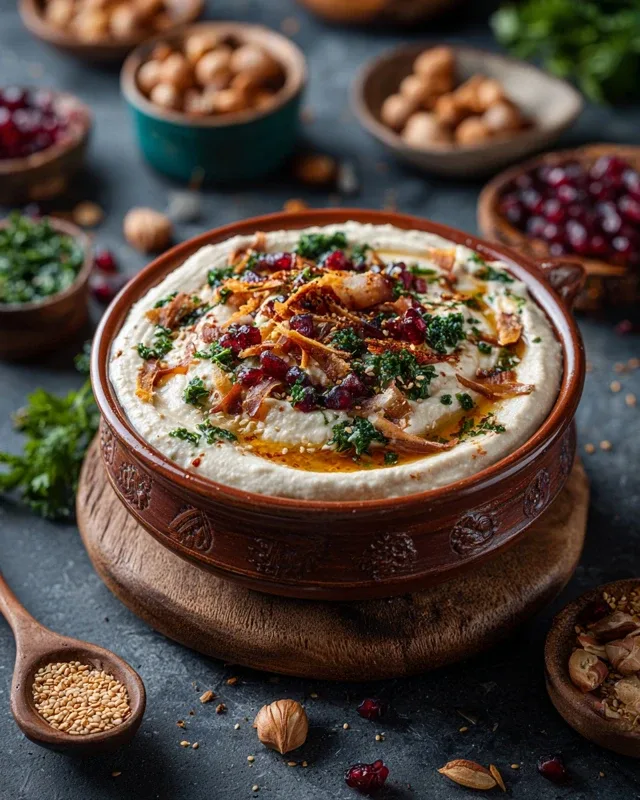There’s a Middle Eastern dish that doesn’t get the global attention it deserves. It’s rich, creamy, crunchy, tangy, warm, and cold — all in one bite. It’s called Hummus Fatteh, also known as Fattet Hummus, and it’s the kind of dish that can make a simple breakfast or brunch feel like a luxurious feast.
Whether you’re a lifelong fan of Levantine flavors or just getting acquainted with the magic of Mediterranean cuisine, Hummus Fatteh is the kind of comfort food that satisfies cravings and invites sharing. This article dives deep — and I mean really deep — into this delicious dish. We’re not just sharing a recipe; we’re unpacking history, techniques, ingredient alternatives, expert tips, serving suggestions, and so much more.
If you’re looking for authentic Hummus Fatteh, you’re in the right place. But even if you’re just hunting for a new way to use that can of chickpeas in your pantry, stick around — because what you’re about to discover might just become your new favorite go-to.
What Is Hummus Fatteh (Fattet Hummus)?
Let’s start with the basics. Fatteh (or fatta, depending on the region) refers to a class of dishes in the Middle East built around toasted or fried pieces of pita bread layered with various ingredients, often including yogurt, chickpeas, meats, and spiced butter.
Hummus Fatteh is the vegetarian version that has earned its place as a staple in homes across Lebanon, Syria, Palestine, and Jordan. At its heart, it’s a humble mix of pantry staples: pita bread, chickpeas, Greek yogurt, garlic, tahini, lemon, and butter or olive oil, usually topped with golden-toasted pine nuts and a sprinkle of fresh parsley.
But don’t let the simplicity fool you. The real beauty of this dish lies in how textures and temperatures combine — warm chickpeas nestled in crispy pita, all smothered in a cool, tangy yogurt-tahini sauce and finished with hot, nutty butter. Every spoonful is a little journey.
Ingredients for the Best Hummus Fatteh
Let’s break down the full list of ingredients that make this Hummus Fatteh recipe an unforgettable one:
Main Ingredients:
- 1 can (15 oz) chickpeas, drained
You can also use freshly cooked chickpeas for even better flavor. - 2 pita breads, toasted and broken into bite-sized pieces
Fresh, slightly stale pita works best for crisping up. - 1 cup plain Greek yogurt
Full-fat yogurt offers the richest flavor and texture. - 2 tablespoons tahini
This sesame paste is non-negotiable for that authentic Middle Eastern depth. - 1–2 garlic cloves, minced
Raw garlic adds a sharp bite. Adjust to taste. - 1–2 tablespoons lemon juice
The brightness lifts the entire dish. - Salt to taste
Topping:
- 2 tablespoons butter or olive oil
Butter is traditional, but olive oil offers a vegan option. - 1/4 cup pine nuts or slivered almonds
Toasted nuts = crunchy, nutty goodness. - Chopped parsley, for garnish
- Paprika or sumac, for garnish (optional but recommended)

Step-by-Step Instructions to Make Hummus Fatteh
This dish comes together in layers. The good news? It’s all quite easy. Here’s how you do it:
Step 1: Toast the Pita
Cut or break pita bread into bite-sized pieces. Toast in a hot oven or skillet until golden and crispy. Set aside. This becomes the crunchy base.
Step 2: Warm the Chickpeas
Drain and rinse chickpeas, then warm them gently in a pot. Set aside a small handful for garnish later.
Step 3: Make the Yogurt-Tahini Sauce
In a bowl, combine:
- Greek yogurt
- Tahini
- Minced garlic
- Lemon juice
- Salt
Whisk until smooth and creamy. Taste and adjust lemon and salt as needed.
Step 4: Build Your Layers
In a large serving dish or individual bowls:
- Start with a layer of toasted pita.
- Add a generous layer of warm chickpeas.
- Spoon over the yogurt-tahini sauce, spreading it evenly.
Step 5: Toast the Nuts
In a small pan, melt butter or heat olive oil. Add pine nuts or almonds and cook over medium heat until golden brown. Watch closely, as nuts can burn quickly.
Step 6: Final Garnishes
Pour the hot, nutty butter over the top of the dish. Garnish with:
- Reserved chickpeas
- Chopped parsley
- A pinch of paprika or sumac for color and zing
Serve immediately while the textures are still distinct — you want that mix of warm and cool, soft and crunchy.
Why Hummus Fatteh Is the Ultimate Middle Eastern Comfort Food
There are countless reasons to love Hummus Fatteh, but let’s dive into what makes it truly special.
1. It’s Incredibly Versatile
You can serve Fattet Hummus for:
- Breakfast (yes, savory breakfasts are the norm in the Middle East)
- Brunch
- Appetizers at a dinner party
- A vegetarian main course
2. It Uses Pantry Staples
This dish was born from the idea of making the most of leftovers — pita, chickpeas, and yogurt — and elevating them into something special.
3. It Offers the Perfect Contrast of Textures and Temperatures
Creamy yogurt sauce, crisp bread, warm chickpeas, crunchy nuts — it’s a party in your mouth.
4. It’s Healthy and Satisfying
Hummus Fatteh is packed with protein, fiber, calcium, and healthy fats, making it a smart, satiating choice.
Tips to Perfect Your Hummus Fatteh Every Time
- Use full-fat Greek yogurt for the richest, creamiest sauce.
- Always toast the pita fresh for max crunch — don’t rely on store-bought pita chips.
- Use fresh garlic and lemon; bottled juice or garlic powder won’t do this dish justice.
- Make it vegan by swapping Greek yogurt for a plant-based yogurt and butter for olive oil.
- Add a drizzle of pomegranate molasses for an optional sweet-tart flavor pop.
- Serve it immediately to enjoy the contrast in textures. Don’t let it sit too long or it turns mushy.
Variations to Try
The beauty of Hummus Fatteh is that it’s endlessly customizable. Try one of these twists:
1. Spicy Fattet Hummus
Add a pinch of cayenne or chili flakes to the yogurt sauce for a kick.
2. Meaty Fatteh
Top it with sautéed ground beef or lamb cooked with onions and spices — a popular variation in Lebanon.
3. Roasted Veggie Fatteh
Roast some eggplant, zucchini, or bell peppers and layer them in with the chickpeas.
4. Vegan Hummus Fatteh
Use plant-based yogurt and olive oil. Sprinkle with dukkah or sesame seeds instead of nuts for crunch.
Serving Suggestions
Pair your Hummus Fatteh with:
- Warm mint tea or Arabic coffee
- Fresh cucumber-tomato salad
- Pickled turnips or olives
- Grilled halloumi or falafel
- Soft-boiled eggs for a protein-rich breakfast twist
This dish shines best served family-style, letting everyone dig into a large platter with spoons or pita.
How to Store Leftovers (If There Are Any!)
While Hummus Fatteh is best enjoyed fresh, you can store parts separately for up to 3 days:
- Yogurt sauce: Store in an airtight container in the fridge.
- Chickpeas: Store separately and reheat before layering.
- Toasted pita: Store at room temperature in an airtight bag to maintain crispness.
- Toasted nuts: Store separately and sprinkle just before serving.
Never assemble ahead — the toasted pita will lose its crunch and turn soggy.
Frequently Asked Questions About Hummus Fatteh
What does “Fatteh” mean?
“Fatteh” comes from the Arabic word fatta, which means “to crumble.” It refers to the torn or crumbled pita bread that forms the base of the dish.
Is Hummus Fatteh the same as regular hummus?
Nope! While both use chickpeas and tahini, Hummus Fatteh is a layered dish, not a purée. It includes yogurt and pita and has a completely different texture and presentation.
Can I make Hummus Fatteh ahead of time?
You can prep components in advance (like the yogurt sauce and chickpeas), but don’t assemble until right before serving to keep that delicious crunch.
What can I use instead of pine nuts?
Slivered almonds, chopped walnuts, or even sunflower seeds can add that toasted crunch if pine nuts aren’t available.
Is this dish gluten-free?
Traditional Hummus Fatteh is not gluten-free because of the pita bread. But you can use gluten-free pita or flatbread to make a suitable version.
How do I make it vegan?
Swap out the Greek yogurt for a thick, unsweetened plant-based yogurt (like coconut or soy-based), and use olive oil instead of butter. The rest of the ingredients are naturally vegan.
Why is my yogurt sauce too runny or too thick?
Yogurt sauces vary based on brand. If it’s too thick, add a splash of water or lemon juice. If too runny, stir in a spoon of tahini to thicken it.
Conclusion: Why You Should Make Hummus Fatteh Today
There’s a reason why Hummus Fatteh remains a beloved dish in the Levant after generations. It’s not just food — it’s comfort, tradition, simplicity, and flavor all in one bite.
If you’ve never tried it, now’s your moment. This authentic Hummus Fatteh recipe uses simple ingredients you probably already have, but the result is something extraordinary. It’s perfect for when you want something hearty yet light, traditional yet fresh.
So toast that pita, warm those chickpeas, and whip up the creamiest yogurt-tahini sauce you’ve ever tasted. Then layer it all together, spoon it up while it’s warm, and let yourself be transported to the streets of Beirut, Damascus, or Amman.
And once you try it? Trust me — you’ll never look at hummus the same way again.
Print
Hummus Fatteh (Fattet Hummus) Recipe: The Creamy, Crunchy Middle Eastern Comfort Food You Need in Your Life
Ingredients
-
1 can (15 oz) chickpeas, drained
-
2 pita breads, toasted and broken into pieces
-
1 cup plain Greek yogurt
-
2 tbsp tahini
-
1–2 garlic cloves, minced
-
1–2 tbsp lemon juice
-
Salt to taste
-
2 tbsp butter or olive oil
-
1/4 cup pine nuts (or slivered almonds)
-
Chopped parsley, for garnish
-
Paprika or sumac, for garnish (optional)
Instructions
-
Toast pita until golden and crispy. Set aside.
-
Warm chickpeas in a small pot. Reserve a few for garnish.
-
In a bowl, mix yogurt, tahini, garlic, lemon juice, and salt until smooth.
-
In a serving dish, layer: toasted pita, warm chickpeas, yogurt-tahini sauce.
-
Melt butter or heat olive oil, add pine nuts, and toast until golden. Pour over top.
-
Garnish with reserved chickpeas, parsley, and paprika or sumac. Serve immediately.
